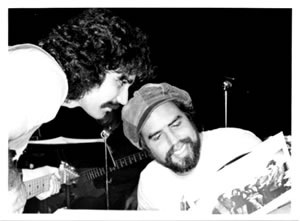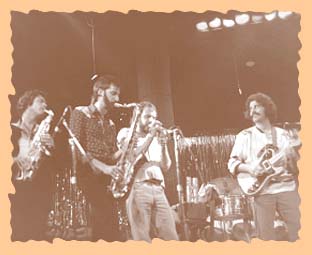Steve Khan's lead sheet:
"The Little Ones"(Randy Brecker)
Without question, I will always consider myself one of the luckiest
musicians alive to have spent so much time playing with both Randy and Michael
Brecker. Each, in his own unique way, has had an undeniable influence on everything that I have
become as a musician. But during my years as part of The Brecker Bros. Band, which preceded my
first three recordings for Columbia Records, there was no question that the influence of Randy's
compositions was as profound as anything else. And so, during the preparation time for both
"TIGHTROPE" and "THE BLUE MAN," I asked Randy if he had an 'extra' tune that
didn't seem to fit on a forthcoming Brecker Bros. recording, and would he let me record it? We had
once rehearsed "The Big Ones" while getting ready for "BACK TO BACK" and so I
knew that I wanted that tune for "TIGHTROPE." When I went over to Randy's downtown
loft to look over some of his tunes, while getting ready for "THE BLUE MAN" in '78, I
heard an untitled piece, which I just fell in love with. I told Randy, "that's the one I want to
record!" He said, more or less, "O.K., you've had the 'Big Ones!' Now you can have, "The Little
Ones." if he had an 'extra' tune that
didn't seem to fit on a forthcoming Brecker Bros. recording, and would he let me record it? We had
once rehearsed "The Big Ones" while getting ready for "BACK TO BACK" and so I
knew that I wanted that tune for "TIGHTROPE." When I went over to Randy's downtown
loft to look over some of his tunes, while getting ready for "THE BLUE MAN" in '78, I
heard an untitled piece, which I just fell in love with. I told Randy, "that's the one I want to
record!" He said, more or less, "O.K., you've had the 'Big Ones!' Now you can have, "The Little
Ones."
Though I will try to control myself from going overboard with praise
for Randy's writing style, but after having spent a goodly portion of a day re-writing this mini-score, I have
to say that this composition is absolutely brilliant! And brilliant in every detail. I recall that I
spent a great deal of time working on the arrangement, and how to bring out the very best in the
piece. I knew that it would be one of several tunes which would utilize the mini-horn section of
the Brecker Bros. Band: Randy Brecker(Trumpet); David Sanborn(Alto Sax); and Michael
Brecker(Tenor Sax). As I had had the benefit of viewing Randy's own mini-scores for his other
compositions, I was intimately acquainted with just how to voice the three horns.
Lucky for me, it was pretty obvious that the [A] melody would lay
best on the guitar, and that [B] and [C] were best suited for the horns. In letter
[B], I simply added the full three voices in places where I felt it was appropriate. Those
spots ended-up being in bar 4, 5, and 7-8. Letter [C] presented different problems, and so
in bar 3, I had the guitar answer the prior horn phrases. Then, from that point forward, the
guitar plays small lines which anticipate the arrival of the next chord change into the following bar.
As [C] is a 9-bar phrase, the guitar finishes off the section and build right back into the
reprise of [A], [A2] which sets up the 1st solo, the guitar solo.
When Randy gave me the chart to the tune, there really wasn't a fully
realized solo section, or a set of solo changes. So, this was another aspect that I had to spend some
time on. As I always try to do, I simply tried to make the most of the material which was
already there in the body of the song. As you can see, the solo changes mirror harmonic movements
which were first presented in both [A] and [B]. [D2] mirrors [B] and to
give it more drive and power, on the repeat, the horn section appears with little hits I arranged
in their style. I was very proud when the three of them didn't laugh at me too much. For those of
you who have questions about the technical aspects of recording this little 3-man horn section ,
what we used to do in those days was to simply double-track the horns and place them in a stereo
image. In essence, they sound like 6 horns! More than this, Randy, David, and Michael know
exactly how to blend with one another, how to phrase as one. Their internal dynamics,
within any phrase, are perhaps the best that one can imagine. And, at this tempo, their short
staccato 16th-notes are exactly the thing which has influenced arrangers, and other horn
sections the world over. This alone make me so very proud to have been a part of this group, and
of the legacy of their ensemble horn playing. ,
what we used to do in those days was to simply double-track the horns and place them in a stereo
image. In essence, they sound like 6 horns! More than this, Randy, David, and Michael know
exactly how to blend with one another, how to phrase as one. Their internal dynamics,
within any phrase, are perhaps the best that one can imagine. And, at this tempo, their short
staccato 16th-notes are exactly the thing which has influenced arrangers, and other horn
sections the world over. This alone make me so very proud to have been a part of this group, and
of the legacy of their ensemble horn playing.
Of course, the horns and the melodies cannot do it alone. Putting the
funk and the soul underneath, giving the "feel" to the written notes was left to Don Grolnick(Keys);
Will Lee(Elec. Bass); Jeff Mironov(Guitar); Steve Gadd(Drums); and Ralph
MacDonald(Percussion). These great, great players sound incredible on this track!!! The
musical and personal familiarity, which existed between all of us, cannot be discounted as a major
contributing factor when assessing just why this track has such a wicked 'hump' to it.
As always, I've tried my best to keep the mini-score down to a minimum amount
of pages. In order to do that, I had to employ not only a D.S. but a D.D.S. and,
in addition to those necessities, I had to use a Coda, and then a Double Coda. But, I
believe that this enabled me to keep the body of the tune within 4 pages. The 5th page simply
becomes our Fade which is now letter [F]. Below you can follow along with the letter layout
of the recorded version:
[I]
[A]
[B]
[C]
[A2] w/ Solo Break
[D] Guitar solo
[D2] Guitar solo continues/take D.S.
[C] w/ coda
[D] Alto Sax solo
[D2] Solo continues/take D.S.
[C] take D.D.S.
[A]
[B] take double coda
[F] Fade(like [B])
As has been stated before, "THE BLUE MAN" recording, though
very popular amongst the core of my '70s fans, has always seemed a bit abrasive where the sound
is concerned. However, this particular track seems to have a bit more warmth to the mix. But I
have no idea why that is. Perhaps because the guitar is simply well integrated into the whole?
One of my great regrets, where the recording of "The Big Ones" on "TIGHTROPE" was concerned, was that I changed one of Randy's chords from an Emaj7#5 to the more expected and pedestrian E7#5. I don't know why, but at that time, I just couldn't "hear" a major7#5 as the V7 chord to the i minor tonic. So, in an attempt to make-up for that gross error in judgment, I made certain that, when we arrived at Pg. 5 and letter [E], the repeats of that section in Abm would all be turned around by an Ebmaj7#5. One year later, this sonority, functioning as a V7 chord, sounded completely 'normal' to me!!! If you have been or have just become a fan of the Brecker Bros., don't ever neglect Randy Brecker's unique writing style. His compositions always deserve to be investigated, because he is truly one of our greatest composers. And so, as we, in New York, are hopefully leaving the brutal heat of August behind, we welcome the cooler temperatures of September, and wish everyone a safe and happy final four months of 2005.
[Photo #1: Steve w/ Randy Brecker @ a New York All-Stars rehearsal ca. '78
Photo #2: Steve w/ David Sanborn; Michael Brecker; and Randy Brecker,
taken by Erika Price @ the Village Gate ca. '75]
|

